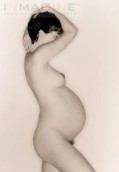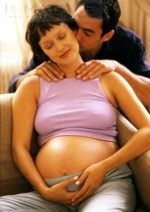What causes pain in labour?
During labour and birth, there are several physical processes occurring that lead to childbirth pain: the strong uterine contractions and the tension they place on supporting ligaments; pressure of the baby on the cervix, vagina, urethra, bladder, and rectum; stretching of the cervix, pelvic floor muscles, and vagina.
These processes are unavoidable, and the pain caused by them is a positive sign that labour is progressing. We don’t want to stop these processes from happening, we just have to figure out how to minimize the pain we experience as a result.
Pain-intensifying factors that we can influence:
– The stretching of the pelvic floor muscles can cause pain; it helps if you’ve been doing your Kegel exercises in advance.
– Pressure on bladder causes pain, going for a wee regularly during labour helps.
– Reduced oxygen to uterine muscle increases pain; breathing techniques help.
– Muscle tension increases pain, fear and anxiety make you more sensitive to pain; relaxation can help with these.
 Your body is AMAZING! It has nurtured another human being for 40 weeks, and is beautifully well equipped to birth your baby into the world. Endorphins are natures own pain killers and are naturally released into the blood stream when the body is physically stressed beyond its normal limits (think of an athlete running a marathon!).
Your body is AMAZING! It has nurtured another human being for 40 weeks, and is beautifully well equipped to birth your baby into the world. Endorphins are natures own pain killers and are naturally released into the blood stream when the body is physically stressed beyond its normal limits (think of an athlete running a marathon!).
The endorphins increase as your labour does – so the key here is to ensure that you are mentally and physically in a state that will encourage endorphins to be released at all times. Your endorphins will modify pain, create a feeling of well-being as well as alter your perception of time and place. The endorphins peak at the transition stage, giving you that extra energy for birth and amnesic effect (forgetting about the pain afterwards). They are at their highest during the pushing stage, which then gives rise to the elation you feel after the birth and encourages bonding with your new baby.
Ways to enhance natural pain killers include:
Position
If you are free to move around and get comfortable, your labour may even speed up. Use gravity to its maximum benefit and try to remain upright as that will encourage your baby’s head to come down. Change positions every 30 minutes or so. Try standing, walking, slow dancing, lunging, sitting upright on a chair, sitting on a birth ball, kneeling, on your hands and knees, sidelying, squatting…the list is endless – find a comfy position that feels good for you.
See some great labour position suggestions in this slide show.
Support
Do not labour alone, surround yourself with positive and encouraging support people. Your partner (and a doula) will help you immensely. Anxiety increases the amount of adrenaline in your body, which in turn reduces the release of endorphins and oxytocin and will slow labour down considerably.
Avoid unnecessary procedures
Procedures with scientific evidence of benefit to you and your baby should be promoted and those without scientific evidence of benefit should be avoided. Avoid the following ‘routine procedures’: pubic shaving, enemas, early artificial rupture of membranes, restriction to bed, intravenous fluids.
Safe Environment
Ideally you want to labour and give birth in a safe and non threatening environment. If you are giving birth in a hospital, make the room your own by bringing flowers, candles, music and turn the lights down or off.
Comfort measures
These include breathing and relaxation techniques to help reduce anxiety and tension. Water (bath, shower or Jacuzzi) is a very effective comfort measure and it encourages you to relax. The best time to get into a bath for pain relief is between 5-6 cm. Sit of stand in the shower and allow the jets of water to massage your back or tummy.
Heat and cold
Alternate between heat and cold to relieve pain or tension. A hot water-bottle, microwave bean bag or warm face cloth. Then try an ice pack, chilled cooldrink can or a cold cloth on your neck, back, shoulders or under your tummy – wherever you need it!
 Massage and touch
Massage and touch
A massage can do wonders for pain. It conveys a comforting message to you that you are loved and being cared for. If you transmit pleasurable impulses (such as light, soft touch), those will reach the brain first and that can modulate, or interfere with, the pain sensations. Firm massage on your back or soft fingertips (called effleurage) over your tummy can all ease the pain of your contractions. Even a foot, hand, leg or shoulder massage can help! In general, sensory input can distract us from pain perception.
TENS machine.
T.E.N.S stands for Transcutaneous Electrical Nerve Stimulation. A TENS machine is quite a nifty little gadget. The unit consists of four flexible, band-aid-size pads connected by wires to a small battery operated generator of electric impulses. The pads stick to the mothers back alongside her lower spine. The mother can regulate the impulses during a contraction. The pulses prevent the pain signals from the contracting uterus and cervix from reaching your brain and also stimulate your body to release its own, natural “feel good” substances, (endorphins.) (Not easily available in SA though…)
Your attitude is very important in labour. Try to relax and believe in yourself and your ability to do something miraculous. Tell yourself, “I AM STRONG. MY BODY KNOWS WHAT IT NEEDS TO DO.”
If you aren’t able to cope and feel overwhelmed by the intensity of your contractions – medicated pain relief is available. You will have made your educated decision beforehand as to what type of pain relief you are willing to accept. Labour and childbirth is not an endurance test – it is a beautiful occasion when a new family is born and an event that you will remember for the rest of YOUR life.



 Posted by JaneFraser
Posted by JaneFraser